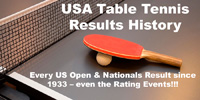March 9, 2015 - Playing in Poor Conditions
Playing a tournament in absolutely perfect conditions is like that mythical annual vacation at the beach where everything goes perfect. But life is not a beach vacation, and neither is table tennis. You not only should be prepared for poor conditions, and as players, you should expect them. This doesn't mean you should just accept them; by all means work to make sure tournament and club directors have great conditions. But as players you have to adapt to the playing environment. Tactical players adapt; non-tactical players complain. Here's a short primer.
- Slippery floors. If your club has great floors, there's nothing more frustrating than showing up at a tournament primed to play like greased lightning, only to find you're playing on a skating rink. Most major tournaments are played on concrete or wood floors, and unless they are treated properly, they will be slippery. So what can you do?
First, have a good pair of table tennis shoes. They are designed to give the best possible traction. Make sure to have a new pair as worn-out ones won't give as much traction. Many players who play at clubs with good floors get lazy on this, letting their shoes wear out, and don't realize this until they are stuck on slippery floors. I suggest getting news ones for such tournaments, and use them only when needed, until the ones you use in practice are falling apart.
Second, step on a wet cloth between points. Watch the top players and you'll see this all the time if they aren't playing on good floors. It can be a wet paper towel or a cloth, it doesn't matter. You'll get much better traction after stepping on it for several points.
Third, use it to your advantage. Players can't move as well on slippery floors, so move them around!
- Poor lighting or background. There's only one good answer here - adjust. You do this by practicing. One common mistake is that sometimes only one side has a bad background. So make sure to practice on both sides of the table, and on any tables you might play on that might have bad backgrounds.
And once again, use it to your advantage. If the lighting or background is poor, it's harder for players to follow the ball. This favors attackers, since defenders are trying to pick up on a fast-moving ball. This doesn't mean wild attacks, but when it's harder to see, play a bit more aggressively, and expect shorter rallies.
- Bad tables, balls, or a breeze. This means the ball is going to take funny hops, or move about in the breeze. It's going to be difficult to play well, so accept that. Rallies will tend be short, and will favor the player who focuses on consistency. This doesn't mean completely changing your game, but focus on keeping the ball in play and letting the opponent make mistakes off the erratic movement of the ball. (Note - there are generally two types of "bad" tables - ones with slippery surfaces, where the ball slides, and ones where the ball dies when it hits near the side-lines or end-lines. Good tables have tops that are thick enough - usually one inch - so the ball bounces consistently all over the surface.)
- Humidity. There's nothing more frustrating than doing that perfect loop you've done ten thousand times before, and the ball slides off your racket into the net. When it's humid, both the ball and racket can get damp, and it'll change the characteristics of how the ball comes off your racket. How do you combat this?
First, make sure to have a dry towel to dry your racket and the ball off with. If you sweat a lot, you should bring two towels, one for you, one for the racket and ball. Then use the towel(s) a lot, making sure the racket, ball, and your hands are dry. (A wet non-playing hand means the ball gets wet; a wet playing hand means you can't grip the racket very well.)
Second, adapt tactically. You won't be able to overpower an opponent with spin, so loopers have to either go to more drive loops (sinking the ball into the sponge, and so less spin, more speed, not as consistent), or steady loops where you mostly keep the rally going. Hitters and blockers have the advantage here, so you might do more of that - but often they too have problems with the humidity as it changes the friction on their racket, and so they block loops into the net. One of the most successful ways to play in humid conditions against a looper is to simply dead block over and over, and watch the poor looper try to loop with any effectiveness.
- Cold. I've seen many players in the winter struggle in their early matches because their racket is cold - and they often don't even notice it. Or they aren't warmed up because their racket was cold when they were warming up, and now that the racket is warmer, it's playing different than it was when they were warming up. A cold racket plays deader. So if you are driving to a tournament and it's cold outside, keep your racket inside the car with you, not in the trunk where it'll get cold.
Finally, a reminder - when faced with bad conditions, you can either surrender to them and lose, or take advantage of them and win. Save the complaining for when you aren't playing, which usually means after the tournament is done.





